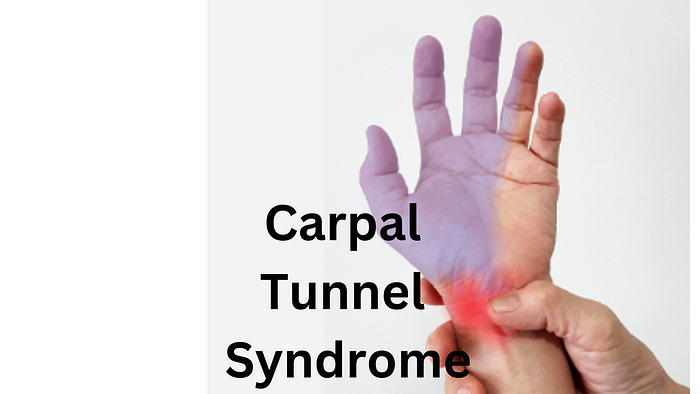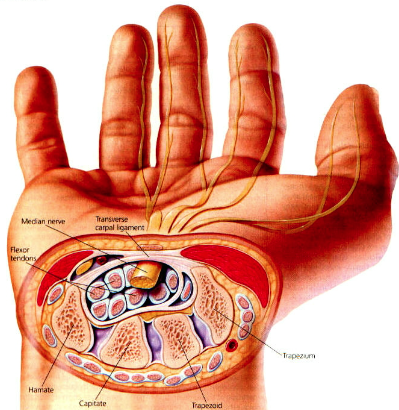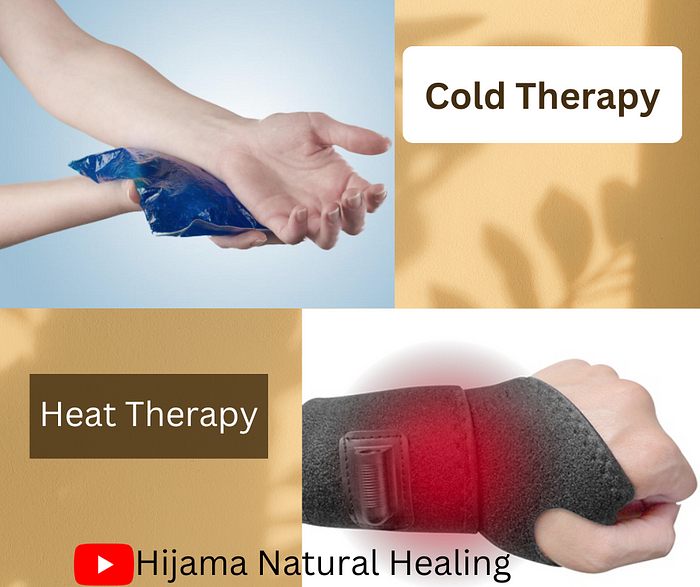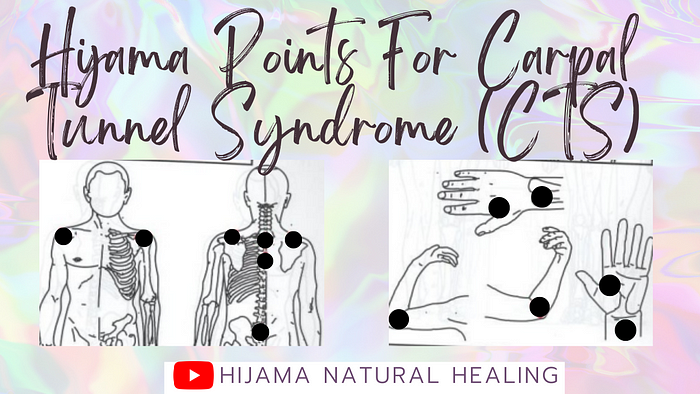#Hijama#Which Therapy Is Best For Carpal Tunnel Syndrome(CTS)?
- Get link
- X
- Other Apps
Being a Hijamist, I witness the treatment of Carpal tunnel with Hijama Cupping therapy and a few lifestyle changes.

Carpal tunnel syndrome(CTS), also called median nerve compression, is a common problem affecting hand function by the compression of the median nerve at the wrist. The carpal tunnel is a narrow pathway with bones and ligaments on the palm side of the hand. The pain gets worse if not treated for a long time. It can also lead to permanent dysfunction of the hand.
The median nerve plays an essential role in the hand. It starts with the neck, travels down the upper arm across the elbow, then passes through the carpal tunnel at the wrist, hands and fingers. Carpal tunnel syndrome occurs when the tunnel becomes narrowed. The tissues around tendons swell. Too much pressure on the median nerve reduces the blood supply.
Anatomy of Carpal Tunnel
The median nerve passes through the carpal tunnel. The carpal tunnel is made of tendons, ligaments and bones.
- The Median Nerve: The median nerve starts from the neck and ends in the hands and fingers. This nerve allows the feelings in the thumb, middle finger, index finger and half of the ring finger. The nerve also controls the muscles of the thumb.
- Tendons: There are nine tendons surrounding the median nerves. The tendons connect the muscles to the bones in the hands. These tendons help the fingers and thumb to bend. These tendons are also called flexor tendons because they aid the fingers and thumb to flex and move.
- Ligaments: The top of the tunnel is surrounded by the connective tissues called the transverse carpal ligaments. These ligaments are very rigid, as they keep the tunnel together.
- Bones: These bones are formed in a semi-circle shape. The bottom and side of the tunnel are made up of these bones.

Symptoms
The symptoms of carpal tunnel syndrome usually start gradually and may occur at any time. These symptoms include:
1- Numbness and tingling that mostly gets worse at night
2- Swollen fingers
3- Burning sensations or itching in the hands
4- Sensation of pins and needles in the hands
5- The numbness may cause weakness and trouble holding objects
6- Inability to perform routine tasks that require simple motions
7- Pain that may travel up the forearm toward the shoulder
8- Poor sleep quality due to pain or numbness
9- Discomfort in the wrists and hands
10- An electric shock-like sensation in the hands
Risk Factors
1- Women are more prone to carpal tunnel syndrome. Women are more tend to have small carpal tunnels.
2- If a small size of carpal tunnel runs in the family, then any family member may have small tunnels.
3- Being obese is another risk factor for CST.
4- Several health conditions are linked to CTS.
5- Working in such an atmosphere where you have to repeat certain motions of your hands may be another risk factor for CTS.
6- Old age
Causes
1- Hormonal or metabolic changes in women, such as pregnancy or menopause, may cause CTS. During pregnancy or menopause, fluid retention may increase the pressure that irritates the median nerve.
2- Sports or a few physical exercises that involve repetitive hand movements may cause CTS.
3- Health conditions like rheumatoid arthritis, diabetes, psoriatic arthritis, hypothyroidism, gout and ganglion cysts may cause CTS. Some health conditions have inflammatory components that may affect the wrist tendons and apply pressure on the median nerve.
4- A wrist fracture or a broken wrist may also cause CTS.
5- Repetitive motions of the hands and wrists may cause significant swelling or irritation in the carpal tunnel that results in enlargement of the tendons and pressure on the median nerve. These movements include typing on the computer, texting, or playing the piano.
Carpal Tunnel Symptoms get Worse at Night time
Carpal tunnel tends to get worse at night because the tissue fluid in the arm becomes redistributed when there is no active muscle pump. When an individual tries to sleep at night, they try not to move much. An inactive position and increased fluid lead to increased carpal tunnel pressure, which makes symptoms of carpal tunnel bad. During the day, an individual gets distracted by daily routine, but at night it is not easy to divert your attention from pain. The temperature always drops at night which is why the concept of pain tends to increase with cold temperatures. Doctors always recommend patients with carpal tunnel syndrome sleep at a nice and cozy temperature to alleviate pain.
Best Diet For CTS
Diet plays an essential role in treating conditions like carpal tunnel syndrome. Eating a healthy diet full of fruits, vegetables, oily fish, seeds, nuts, and whole grains may reduce inflammation, which may help to control symptoms of CTS. Poor blood flow may cause pain, muscle cramps, digestive issues and cold hands or feet. Circulatory problems can be treated by eating certain foods. So, here are some best foods to optimize blood flow that reduces numbness and tingling:
1-Garlic: It is rich in Sulphur which helps blood vessels relax. It improves blood flow through the heart. It also reduces the workload on the heart. Blood pressure reduces when the heart doesn’t have to work hard to pump the blood.
2-Onions: Flavonoid antioxidants and anti-inflammatory properties in onions may be linked to reducing the inflammation in the arteries and veins. Onion boosts blood flow and benefits heart health.
3-Ginger: It aids digestion and relieves nauseating feelings. It widens blood vessels and reduces blood pressure which benefits blood circulation.
4-Cinnamon: It improves blood circulation and increases heart health.
5-Cayenne pepper: Cayenne red pepper has a compound called capsaicin which promotes blood flow to the tissues by lowering blood pressure. It strengthens the blood vessels and reduces plaque built up in the arteries.
6-Turmeric: The golden yellow colour of turmeric is derived from a compound called curcumin which may widen blood vessels. With wider veins, blood reaches the heart, lungs, organs, tissues and muscles.
7-Citrus Fruits: Antioxidants in citrus fruits like oranges, lemons, and grapefruits reduce inflammation, boost blood circulation and prevent blood clots.
8-Walnuts: Walnuts are loaded with beneficial compounds that may reduce blood pressure, improve blood function also reduce inflammation. People with diabetes often have circulation issues also high blood pressure due to poor blood circulation walnuts may help with diabetes.
9-Omega-3 fats: Omega-3 Fatty acids increase blood flow and help to keep arteries unclogged.
10-Beets: Beet juice widens arteries, lowers blood pressure, also improves athletic endurance. Many athletes use beet juice or beet powder to enhance performance.
Doctors acknowledge that the best way to get rid of inflammation is not by taking regular medicines or performing surgeries but by taking care of your diet. An anti-inflammatory diet may help fight against inflammation for good.
Science has proven that inflammation can become a silent killer contributing to severe health conditions such as cardiovascular diseases, type-2 diabetes, arthritis, carpal tunnel syndrome and other diseases.
The food that we eat can significantly affect inflammation in the body. The symptoms of CTS can be characterized by increased inflammation. Some foods with certain ingredients can trigger inflammation, discussing some of them.
- White bread, pasta, pastries, sweets, some cereals, cakes, cookies, and all processed foods that contain added sugar or flour are examples of refined carbs.
- Sodas, soft drinks and all other sweetened beverages
- Red meat and processed meat like hot dogs
- Some vegetable oil like soybean oil
- Processed snack foods like chips and crackers
- Artificial trans fats such as margarine, shortenings
- Foods with gluten may trigger the symptoms of inflammation
- Plants in the nightshade plant family, such as eggplant, peppers, and potatoes, should also be avoided. Despite the limited evidence to support this, a person can try removing them from their diet to see if their symptoms improve.
Treatments For Carpal Tunnel Syndrome
When it comes to treating carpal tunnel syndrome, several options may help to ease the pain. Every human body functions differently; the approach to getting relief from pain is always different. It always gets worse if an individual doesn’t treat it timely. Early treatment makes the recovery time way shorter than usual.
1- Wearing a Splint or a Brace
A wrist splint keeps the wrist of an individual straight. The neutral position of the wrist reduces the pressure on the nerve in the carpal tunnel. Most people prefer wearing the splint at night to keep the wrist from bending while they sleep. It may also help to wear it during the day to aggravate the symptoms while working. Try to wear the splint for at least four weeks before it starts to feel better.
2- Physical Activities For CTS
Physical activities like exercise and yoga help people with minor to moderate cases to relieve the pain and avoid surgery. It is evident to consult your doctor before performing these exercises.
- Shake your hands out
- Basic wrist stretches
- Wrist rotation
- Finger stretch
- Thumb stretch
- Prayer stretch
- Median nerve glide
- Wrist flexor stretch

3- Adjust your Sleeping Position
Carpal tunnel syndrome gets worse at night and interferes with your ability to get a good night’s sleep. Try to make a few simple changes to your sleeping position to help improve your sleep.
Although it is not proven, some doctors suggest that sleeping on one side may increase the risk of developing CTS. When an individual sleeps on one side, the wrist is more likely to be compressed in this position.
Place a pillow underneath your affected arm while sleeping. The support of the pad or a soft pillow to the arm helps relieve tension and reduce pain.
4- Cold Therapy
Using ice for CTS may help to control the pain and stiffness. When cold therapy is applied to the wrist, it reduces the blood flow to the affected area and decreases swelling by constricting the blood vessels. Cold therapy slows down nerve activity and minimizes hand pain by numbing the affected area. Apply the ice pack for 10 to 15 minutes. Cold therapy is more effective in the early days of CTS. Cold therapy helps to stop the condition from getting worse.
5- Heat Therapy
Unlike cold therapy, heat therapy dilutes the blood vessels and enhances the blood flow. It allows oxygen to enter the affected area and speeds up the healing process. More oxygenated blood helps to recover the injury faster. Overexposure to heat therapy can make the inflammation and swelling worse, so take extra caution before doing heat therapy.

6- Massage Therapy
Massage therapy is considered a beneficial technique to improve the symptoms of CTS. Massage along with a few stretches and exercises may provide short-term pain relief. Massage may help reduce swelling and pain, enhances the strength of holding objects, increases the range of motion and boosts blood circulation around median nerves.
Many people have yet to hear of hand therapy, it is a therapy that involves the treatment of the upper limb which includes the hand, wrist, elbow and shoulder. Hand therapy can be beneficial for carpal tunnel syndrome. A hand therapist is a medical professional that works with patients to treat and restore their function to participate in routine life.
8- Acupuncture Therapy
Acupuncture therapy is also considered an effective therapy to reduce the symptoms of CTS. A 2021 study noted that acupuncture may help with mild to moderate symptoms of carpal tunnel syndrome. Acupuncture therapy involves inserting pins and needles through the skin. These specific areas are called acupuncture points.
9- Keep Yourself Warm
Cold weather plays a very important role to alleviate pain, caused by carpal tunnel syndrome. The human body is designed in a way that when the temperature drops, the blood vessels become narrow. The heart has to work very hard to pump blood. When the blood flow decreases in the hands and around the median nerve, the symptoms of CTS become worse. Prepare your body for cold weather by keeping yourself warm.
10- Hijama Cupping Therapy
Hijama cupping therapy is a traditional alternative medical treatment practiced in different cultures. The ancient Egyptians, Chinese culture, Arabic medicine, Greek medicine, and Prophetic medicine all practiced other types of cupping. Even though the crux of performing cupping is to alleviate the pain by increasing blood circulation and eliminating the toxins from the body. Cupping also helps to reduce pain and inflammation and increases blood flow which provides relaxation and well-being to the body.
For centuries, Hijama cupping therapy has been used as a safe and common method to handle issues with soft tissues and stiff muscles. When cups are applied on the targetted area of the skin, it creates negative pressure. The negative pressure helps to reduce the tension and stiffness in the muscles and also aids to release the myofascial and scar tissues.
When cups are applied around the median nerve, it helps to release the pressure. The compression on the median nerve causes pain and swelling. After cupping therapy when the pressure is released, it reduces pain and swelling. Hijama also helps to improve nerve tissue viscoelastic function and blood circulation around the median nerve. Hijama increases blood flow and treats a large number of blood disorders.
According to a 2017 study, the mechanism of cupping therapy increases blood flow and stretches the internal organs and tissues.
Cupping therapy helps improve tissue and muscle stiffness, remove toxic blood, expel heat, help with pain management and relieve stress. Cupping therapy moves the toxins away from the organs and harvests them out of the skin with the help of incisions made on the surface of the skin.
Cups applied at the shoulder-neck region, are very effective for CTS because of the connective tissue zone. It increases microcirculation that may relieve symptoms of CTS.

According to a 2019 study, Hijama cupping therapy is an effective technique for providing relief of pain and stiffness from carpal tunnel syndrome. Hijama cupping therapy was performed on both hands at the front and back of the carpal region and the back region. The patient felt immediate relief after the therapy.
Another study published in 2019 in The Journal Of pain, experienced fascinating results from cupping therapy. Results showed that CTS patients who are given cupping treatment have a highly significant decrease in pain and other symptoms.
According to my experience, a single treatment of Hijama cupping therapy for carpal tunnel syndrome improves functional ability and quality of life for some time.
- Get link
- X
- Other Apps


Comments
Post a Comment